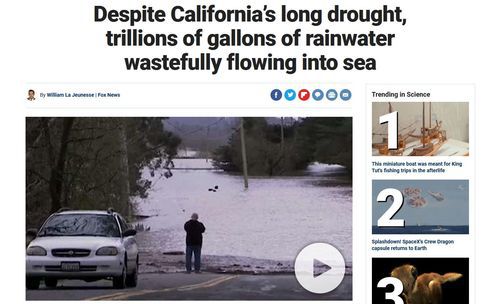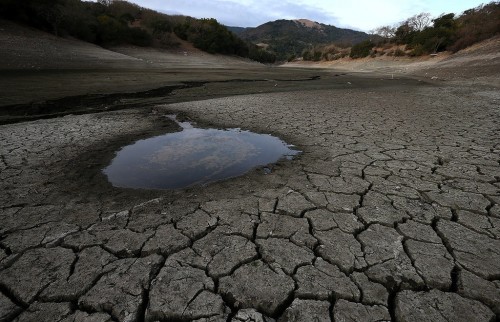


03/08/2019
Democrat-run California didn’t learn much from the recent five-year drought that left many reservoirs close to empty.
Below, the depleted Almaden Reservoir near San Jose, California, in February 2014.

This year’s rainy season has seen the skies open up and dump incredible quantities of the wet stuff, which is always welcome in the drought-prone Golden (brown) State.
California is also a highly populated state — hovering around 39 million persons — in part because its recent governors have been very welcoming to foreigners, with one result being a population that includes 27 percent foreign born, the highest in the US.
In fact, in 2014 Jerry Brown famously invited all of Mexico to move here, remarking to a Mexican audience, “You’re all welcome in California.”
Democrats like Jerry Brown love to imagine themselves as virtuous environmentalists saving the planet, but they have no problem causing preventable population growth in a nation reputed to have excessive resource consumption.
So you might think that Sacramento would get serious about building water storage infrastructure to prepare for the next drought. But not really, as explained by a recent report:
Despite California’s long drought, trillions of gallons of rainwater wastefully flowing into sea, By William La Jeunesse, Fox News, March 5, 2019
LOS ANGELES — California’s rainy season could be the wettest in 40 years, but experts say the state is missing a major opportunity by failing to collect the trillions of gallons of storm runoff that currently flows wastefully into the ocean.
“We will never capture it all, but we need to do a better job of capturing what we can,” said Peter Gleick of the Pacific Institute.
In February alone, an estimated 18 trillion gallons of water fell on the state. In urban areas and coastal cities, 80 percent ends up diverted into the ocean, as Los Angeles and other cities built long concrete channels for flood control. The Los Angeles River, for example, is a 51-mile-long canal as wide as a football field. Almost none of the water seeps into the underground aquifer.
“The challenge is: How do we capture more of that water to use it so we can use it during dry parts of the year? And cities in California have not historically done a good job of capturing what we call stormwater,” said Gleick, who helped author a study showing how San Francisco and Los Angeles could harness nearly as much water as they consume.
In the past, the state relied on a vast network of nearly 50 dams and reservoirs to capture and bank snowpack from the Sierra Mountains. Snow that melted in the spring and summer was pumped south into the Central Valley for growing and to serve thirsty cities till the rainy season begins in December.
For years, the system worked seamlessly, providing for economic growth and agricultural expansion. But the last dam built in California was 40 years ago. Since then, the population doubled.
The state handled previous droughts in 1976 and 1988. But the last five-year drought, from 2011 to 2015, brought a 25 percent mandatory reduction. Crops died, farmers went out of business and then-Gov. Jerry Brown proposed fining residents $10,000 a day for wasting water.
Suddenly the state realized it needed a new approach. Voters approved $2.7 million in bonds for new water storage projects. The first of those, however, is still five years away from completion — and many won’t be done until 2030 or beyond, leaving the state vulnerable to the next drought.
“As Californians, we have to pull together and save water in every way we can,” Brown said at the time. (Continues)